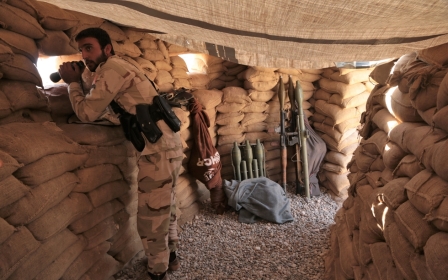'Tel Aviv will turn to dust': Iran taunts Israel during missile parade

Iran taunted Israel and the United States on Wednesday as it marked the anniversary of the 1980 Iraqi invasion by parading its latest missile and naval technology.
At a parade in Tehran, shown on state television, the armed forces displayed an array of military vehicles and what was described as multi-warhead missiles, along with the S-300 surface-to-air missile defence system, supplied by Russia.
The state news agency, Fars, said the display included the Zolfaqar, the latest generation of Iran's long-range ballistic missiles which is capable of carrying "multiple re-entry vehicles" (MRVs), a payload which can hit several targets independently.
A report on Fars said one of the missiles on display had a message written on it in Hebrew which declared "Israel should be wiped off the Earth".
Another banner read: "If the leaders of the Zionist regime make a mistake then the Islamic Republic will turn Tel Aviv and Haifa to dust."
The Zolfaqar is the legendary sword which was said to have been given to Ali ibn Abi Talib by his father-in-law, the Prophet Muhammad.
Major General Mohammad Hossein Baqeri, the chief of staff of Iran's army, said Iran had advanced its weapons technology after the US recently signed a $38bn military aid deal with Israel to run over the next decade.
"The criminal (US) move to sign an agreement to present a supportive military package to the Zionist regime is a desperate attempt to protect the security vacuum of the regime [Israel] and makes us more determined to increase our military power," he said.
Baqeri declared that Iran wanted peace. But he also said Iran's lessons from the eight-year war with Iraq now served as a guide for "our brothers in faith" in Syria, Palestine, Lebanon, Iraq, Afghanistan, Yemen and Bahrain - a checklist of countries where Iran has political, religious or military allies.
Meanwhile, at the port of Bandar Abbas on the Gulf, the navy showed off 500 vessels including stealth-like ships, as well as submarines and helicopters.
The display comes at a time of high tension with the United States in the strategic Strait of Hormuz. US officials say there have been more than 30 close encounters between US and Iranian vessels in the Gulf so far this year, more than twice as many as in the same period in 2015.
On 4 September, a US navy coastal patrol ship changed course after an Iranian Revolutionary Guard fast-attack craft came within 90 metres of it in the central Gulf, at least the fourth such incident in less than a month, according to US Defense Department officials.
"We tell the Americans that it's better that the capital and wealth of the American people should not be wasted on their inappropriate and detrimental presence in the Persian Gulf," said Major General Mohammad Ali Jafari, the commander of the Islamic Revolutionary Guard Corps.
The Tasnim news site quoted him as saying: "If they want to extend their reach and engage in adventurism they should go to the Bay of Pigs" - a reference to the location of a botched US-backed attempt to overthrow Cuba's leader, Fidel Castro, in 1961.
The Russian missile defence system on show in Tehran was deployed last month around Iran's underground uranium enrichment facility at Fordow, 200km to the south of Tehran.
Enrichment at the site has stopped since the implementation in January of Iran's agreement with world powers to curb its nuclear programme in exchange for an easing of sanctions.
Also on display was the Qadr H missile, which has a range of 2,000km, according to state TV. Iran's ballistic missile programme has been criticised by the West, and the US treasury imposed sanctions on two Iranian companies in March because of their alleged ties to it.
Middle East Eye propose une couverture et une analyse indépendantes et incomparables du Moyen-Orient, de l’Afrique du Nord et d’autres régions du monde. Pour en savoir plus sur la reprise de ce contenu et les frais qui s’appliquent, veuillez remplir ce formulaire [en anglais]. Pour en savoir plus sur MEE, cliquez ici [en anglais].





